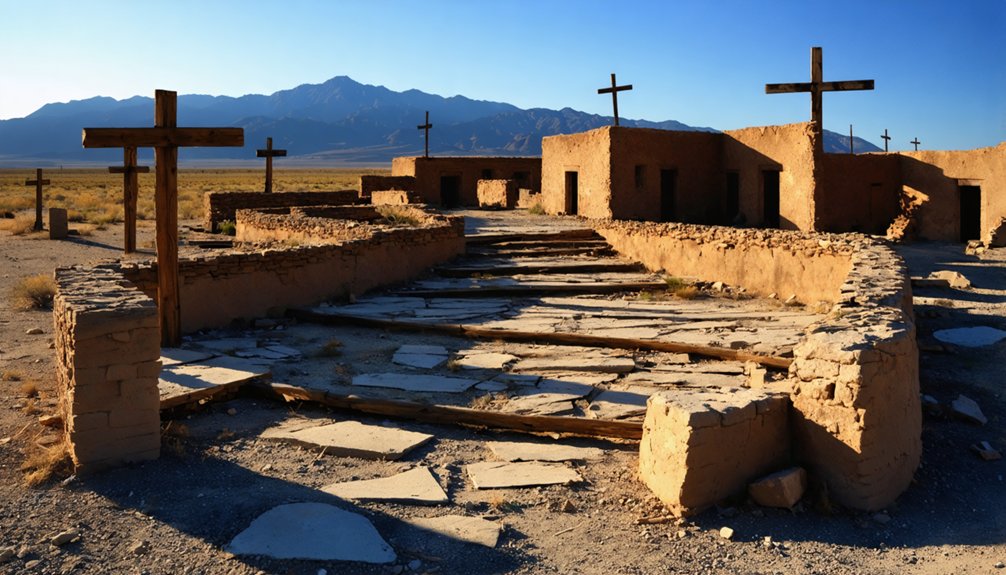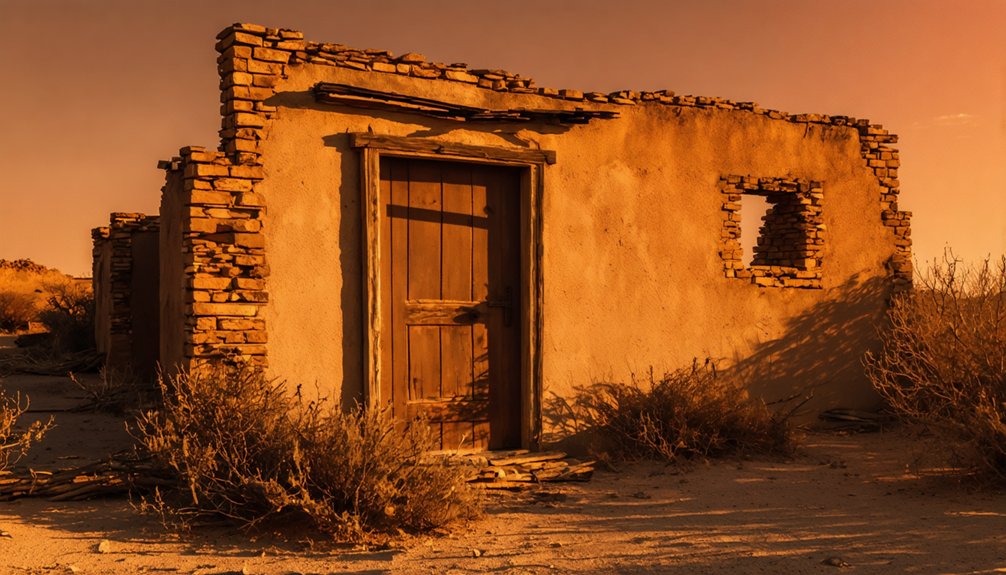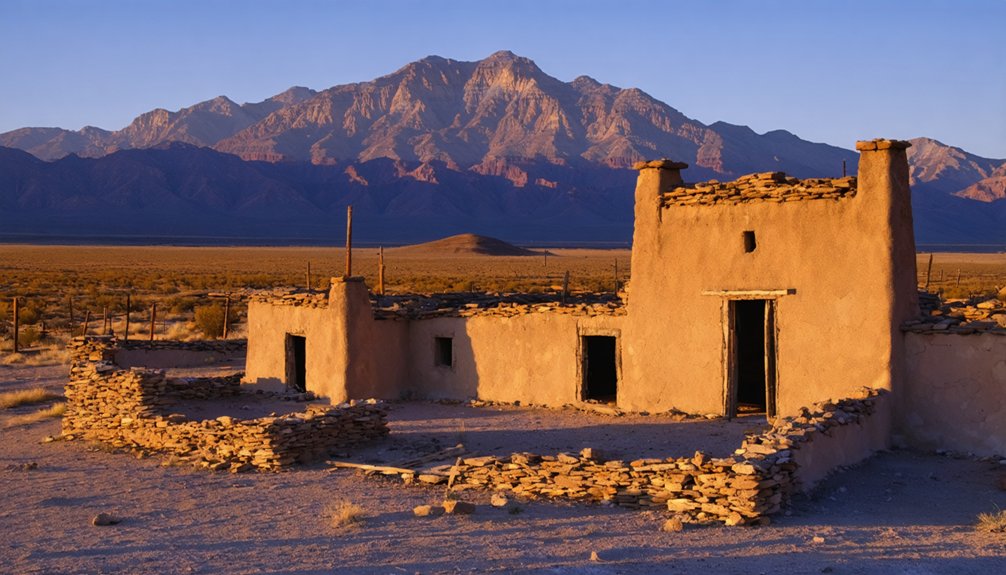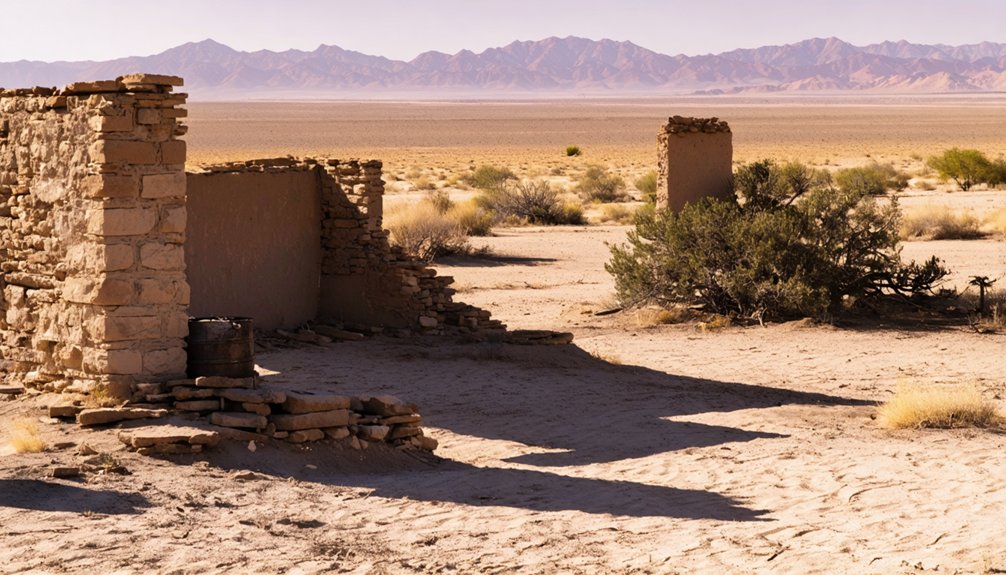Porvenir, Texas was once a vibrant Mexican-American farming settlement along the Rio Grande that met a tragic end in 1918. You’ll find its remains in northwest Presidio County, where 140 residents once cultivated crops through innovative irrigation. The community’s destruction came when Texas Rangers, U.S. soldiers, and local ranchers executed 15 Mexican men and boys, forcing survivors to flee. This dark chapter of racial violence transformed Porvenir into an abandoned ghost town, its story echoing through Texas history.
Key Takeaways
- Porvenir became a ghost town after the 1918 massacre when surviving residents fled to Mexico, abandoning their homes and farmland.
- The settlement once housed approximately 140 residents who farmed along the Rio Grande using innovative irrigation techniques.
- Only ruins and archaeological evidence remain at the original townsite, located in northwest Presidio County near the Texas-Mexico border.
- The community’s school building and farming structures were left to decay after the tragic events of January 28, 1918.
- A Texas Historical Commission marker now stands near the former townsite, commemorating the massacre that transformed Porvenir into a ghost town.
The Rise of a Border Village
Along the rugged banks of the Rio Grande in northwest Presidio County, Texas, Porvenir emerged as a modest yet hopeful settlement in the early 20th century.
You’ll find this village development nestled against the Sierra Vieja range, 24 miles southwest of Valentine, where approximately 140 residents carved out their existence in the arid desert landscape.
The settlement’s name, meaning “future” in Spanish, reflected the aspirations of its Mexican-descent inhabitants. Through innovative agricultural practices, families like the Moralez and Nieves established productive farms by diverting Rio Grande water for irrigation.
Named for the Spanish word for “future,” Porvenir’s determined farmers created fertile farmland by channeling Rio Grande waters to their fields.
Despite harsh conditions, they cultivated cotton and raised livestock while maintaining strong cultural ties. The village’s commitment to progress was evident in its small public school, where Harry Warren educated about twenty local children. This same Harry Warren would later become a key witness when he documented the massacre of fifteen villagers. The village gained additional infrastructure when a post office was established in 1926.
The Fateful Night of January 28, 1918
You’ll find that terror struck Porvenir in the early hours of January 28, 1918, when Texas Rangers, local ranchers, and U.S. Army soldiers surrounded the village and forcibly separated fifteen Mexican males from their families.
These men and boys were then marched to a nearby bluff where Rangers and ranchers executed them by gunfire, while Army cavalry remained near the village.
The massacre left widows and orphans to bury their dead across the border in Mexico, forever altering the fabric of this once-peaceful farming community. The victims left behind forty-two children in total, many from families who owned substantial land in the area. Governor Hobby later disbanded Company B of the Texas Rangers in response to evidence of their involvement.
Midnight Raid Begins
While tensions remained high following the initial searches two days prior, a combined force descended upon Porvenir in the early morning hours of January 28, 1918.
In the darkness, 10 Texas Rangers, 8 U.S. Cavalry soldiers, and 4 local Anglo-American ranchers surrounded the sleeping village. The midnight operations reflected careful coordination between the groups, with cavalry taking positions near the settlement while Rangers and ranchers moved through the streets.
You’d have witnessed the armed men awakening villagers from their homes, creating immediate community tension as they separated Mexican men and boys from women, children, and Anglo residents. The Rangers had already searched these homes on January 26, finding only two weapons during their previous raid. The attackers would ultimately select fifteen victims for execution outside the village.
The attacking force, led by Captain Fox, methodically lined up the residents while John Pool, Buck Pool, Raymond Fitzgerald, and Tom Snyder assisted in controlling the increasingly frightened population.
Mass Execution at Bluff
The tragic sequence of events reached its brutal climax as the armed group marched fifteen Mexican men and boys to a nearby bluff outside Porvenir.
Captain Fox’s Texas Rangers Company B, alongside four local ranchers, led the victims to their deaths while U.S. Cavalry troops remained near the village. Among those taken were teenagers as young as 15 and elders up to 72 years old, including landowners Manuel Moralez and Román Nieves.
In the early morning darkness of January 28, 1918, the mass execution forever shattered the community’s peace. The victims’ families were left to mourn forty-two orphaned children.
The Rangers and ranchers fired upon the unarmed victims, leaving their bodies to be discovered the next day by a local teacher and a victim’s son.
Governor William Hobby later disbanded Company B after the massacre.
These devastating moments would sear themselves into community memories as surviving residents fled across the border into Mexico.
Families Forever Changed
On that fateful January night in 1918, armed men shattered dozens of families’ lives as they stormed through Porvenir’s quiet streets, forcibly separating husbands, fathers, and sons from their loved ones.
You’d find the community’s resilience tested as Texas Rangers, local ranchers, and U.S. cavalry soldiers dragged 15 innocent Mexican men and boys to their deaths, leaving behind terrified women and children.
In the wake of this horror, you’d witness 140 survivors fleeing across the border to Mexico, carrying with them an unfathomable familial trauma that would echo through generations.
The massacre was triggered by accusations about a nearby Brite Ranch raid, though the victims had no connection to that incident.
The survivors’ sworn testimonies to Mexican authorities preserved the truth of that night, even as U.S. forces razed their village, attempting to erase all evidence of the thriving community that once called Porvenir home.
The victims’ families were left to mourn forty-two orphaned children, their fathers having been landowners with substantial property before the massacre.
Life Before the Massacre
Nestled along the Rio Grande in northwest Presidio County, Texas, Porvenir thrived as a modest farming and ranching settlement before its tragic end.
Despite the harsh desert climate, you’d have found remarkable community resilience among the mainly Mexican-American families who owned land and worked the soil.
Manuel Moralez and other resourceful farmers developed innovative agricultural practices, creating irrigation systems that transformed arid lands into productive cotton fields.
You’d have witnessed children attending the local school run by Harry Warren, while their parents tended to livestock and crops.
The Bonilla, Flores, Gonzalez, Jáquez, Lares, Moralez, and Nieves families forged a self-sufficient existence through daily cooperation and shared cultural bonds, even as mounting border tensions and militarization cast growing shadows over their peaceful way of life.
The Texas Rangers’ Role

While you might expect the Texas Rangers would face severe consequences for executing fifteen unarmed Mexican Americans at Porvenir, their accountability was limited to the disbandment of Company B and the dismissal of only five Rangers.
Through legislative charges filed by Representative J.T. Canales and investigations by multiple agencies, you’ll find that the Rangers’ false claims of justified force were thoroughly discredited.
The massacre exposed a darker side of the Rangers’ legacy, revealing their role in state-sanctioned violence against ethnic minorities along the Texas-Mexico border.
Accountability Never Came
Despite mounting evidence of their involvement in the Porvenir massacre, the Texas Rangers largely escaped meaningful accountability for their actions.
While Governor Hobby disbanded Company B and dismissed five Rangers, including Captain Fox, others simply transferred to different companies – a clear example of justice denied.
The systemic failures became evident through Captain Hanson’s compromised investigation, which attempted to justify the killings by falsely portraying victims as criminals.
Even the Canales Investigation of 1919-1920, which exposed widespread Ranger abuses including murder, torture, and illegal imprisonment, failed to secure criminal prosecutions.
The presence of local ranchers and U.S. Army cavalry during the massacre complicated accountability efforts, as official reports deliberately mischaracterized the event as a shootout rather than cold-blooded murder.
Dark Chapter Exposed
The Texas Rangers’ role in the Porvenir massacre has emerged as one of the darkest chapters in Texas law enforcement history.
Under Captain James Monroe Fox‘s command, Company B collaborated with local Anglo ranchers and U.S. cavalry to round up fifteen unarmed Mexican American men and boys from the village.
Though they’d found no evidence linking residents to the Brite Ranch raid, the Rangers proceeded with extrajudicial executions, reflecting the racial tensions that plagued the border region.
You’ll find the historical implications of this event reach far beyond the immediate tragedy.
The Rangers initially fabricated claims of a shootout and criminal involvement, but investigations by both Mexican and U.S. authorities exposed the truth.
While Governor Hobby disbanded Company B and forced several resignations, true justice remained elusive – no criminal charges were ever filed.
Surviving Witnesses and Their Stories
Among the few who survived the Porvenir massacre, Juan Flores emerged as the last living eyewitness, carrying the burden of his traumatic memories for nearly a century.
Survivor accounts reveal how Texas Rangers and local ranchers forcibly removed men from their homes, bound them, and executed them in cold blood. The massacre’s devastating impact created lasting family trauma, displacing entire families and leaving 47 children without fathers.
- Juan Flores finally broke his silence at age 95, providing vital testimony
- Archaeological evidence has validated Flores’s eyewitness account
- Rosendo Mesa survived by chance, being away during the killings
- Fifteen men and boys were murdered that day
- Surviving families fled across the border to Mexico for safety
The survivors’ testimonies have become instrumental in challenging historical denial and documenting this dark chapter of Texas history.
From Thriving Community to Abandonment

Once thriving as a close-knit ranching and farming settlement of 140 people, Porvenir embodied the spirit of border life through its blend of Mexican-American families who cultivated cotton fields, maintained livestock operations, and built prosperous lives along the Rio Grande.
You’ll find that despite challenging conditions, the community’s resilience shone through their shared cultural heritage, educational values, and cooperative farming practices.
Yet this vibrant settlement met a tragic end when Texas Rangers and civilians executed 15 men and boys on January 28, 1918. The massacre shattered Porvenir’s social fabric, forcing survivors to flee their homes and abandon their livelihoods.
The Rangers’ brutal massacre of innocent villagers ripped apart Porvenir’s community, sending survivors fleeing from their once-peaceful home.
Within days, the once-bustling community stood empty – its irrigation systems untended, its livestock scattered, and its closely woven social bonds permanently torn apart.
Historical Recognition and Modern Research
For nearly a century, Porvenir’s tragic history remained buried in silence until modern scholars, descendants, and historians began unearthing its painful past.
The historical significance of this event gained official recognition in 2018 when the Texas Historical Commission dedicated a marker in Marfa, acknowledging the massacre’s impact on public memory and border history.
- Dr. Monica Muñoz Martinez submitted the marker application through THC’s Undertold Stories program
- Descendants conducted extensive genealogical research, uncovering hundreds of archival documents
- The Texas State History Museum first acknowledged the tragedy in 2016
- Local resistance initially complicated efforts to establish historical recognition
- Academic research helped frame the massacre within broader border violence contexts
You’ll find that this recognition marks a turning point in Texas history, challenging sanitized narratives and emphasizing the importance of confronting difficult truths about the past.
Legacy of Border Violence and Racial Injustice

While Porvenir’s tragic massacre stands as a singular event, it represents a broader pattern of state-sanctioned violence and systemic racism that pervaded the Texas-Mexico border region in the early 20th century.
You’ll find that Texas Rangers operated with impunity, engaging in racial profiling and violence against Mexican Americans, indigenous peoples, and Black Texans.
The systemic oppression extended beyond individual acts of violence. Mexican Americans faced widespread marginalization, with little legal protection or recognition of their civil rights.
The militarization of the border region, with over 100,000 U.S. troops present, enabled law enforcement to abuse their power against minority communities.
This legacy of injustice created generational trauma, as families like those who fled Porvenir lived under constant threat of displacement and violence.
Frequently Asked Questions
What Natural Resources or Minerals Were Found in the Porvenir Area?
You’ll find significant mineral deposits including copper, mercury, and potential rare earth elements, while natural resources extend to cobalt, nickel, and uranium in the surrounding geological formations.
Are There Any Remaining Structures or Ruins Visible at Porvenir Today?
You won’t find any remaining buildings at the site today. Time and abandonment have erased most ghostly remnants, leaving only subtle traces that archaeologists might detect through careful study.
How Did Residents Access Medical Care in Early 1900S Porvenir?
While formal healthcare access was scarce, you’d find residents relying on family healers, traditional remedies, and dangerous journeys to distant towns like Marfa for serious medical practices and emergencies.
What Traditional Celebrations or Festivals Were Observed in Porvenir Before 1918?
You’d have experienced traditional festivities centered on Catholic feast days, with cultural heritage expressed through Mexican music, dance, and communal meals during religious holidays, patron saint celebrations, and family gatherings.
Did Any Archaeological Excavations Take Place at the Porvenir Site?
You’ll find significant archaeological findings from the 2015 excavation history, where researchers discovered military ammunition, civilian artifacts, and cartridge casings that revealed new evidence about U.S. military involvement.
References
- https://www.sulross.edu/porvenir-the-quiet-massacre/
- https://www.thestoryoftexas.com/discover/artifacts/harry-warren-porvenir-notebook-spotlight-1-1-19
- https://time.com/5682139/porvenir-massacre-descendants/
- https://www.marfapublicradio.org/2016-01-28/a-new-look-at-the-porvenir-massacre-of-1918
- https://en.wikipedia.org/wiki/Porvenir
- https://www.tshaonline.org/handbook/entries/porvenir-massacre
- https://www.tshaonline.org/handbook/entries/porvenir-tx
- https://www.youtube.com/watch?v=1WhjOMVDLWM
- https://www.tandfonline.com/doi/abs/10.1080/15740773.2022.2119918
- https://www.zinnedproject.org/news/tdih/porvenir-massacre/



